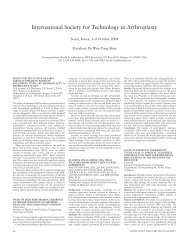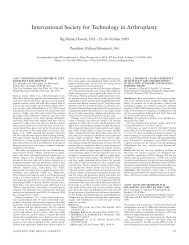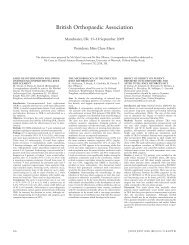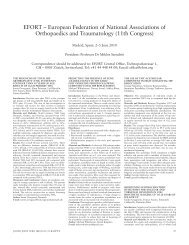Procs III 2011.indb - Journal of Bone & Joint Surgery, British Volume ...
Procs III 2011.indb - Journal of Bone & Joint Surgery, British Volume ...
Procs III 2011.indb - Journal of Bone & Joint Surgery, British Volume ...
Create successful ePaper yourself
Turn your PDF publications into a flip-book with our unique Google optimized e-Paper software.
344 HELLENIC ASSOCIATION OF ORTHOPAEDIC SURGERY AND TRAUMATOLOGY<br />
030 HUMERAL AND GLENOID BONE<br />
LOSS AS FACTORS OF RECURRENCE<br />
AFTER ARTHROSCOPIC TREATMENT OF<br />
SHOULDER INSTABILITY<br />
E. Mataragas, C. Vassos, N. Tzanakakis, G.<br />
Mouzopoulos, C.K. Yiannakopoulos, Emm.<br />
Antonogiannakis<br />
Arthroscopy and Shoulder Unit, IASO<br />
GENERAL Hospital<br />
To evaluate humeral and glenoid bone loss in patients<br />
surgically treated for shoulder instability as factors <strong>of</strong><br />
recurrence.<br />
During the period 2000-2008, 114 patients (103 men<br />
and 11 women) with mean age <strong>of</strong> 28 yrs underwent<br />
arthroscopic treatment for shoulder instability by the<br />
same surgeon. Mean age <strong>of</strong> the 1st shoulder dislocation<br />
was 20,89 yo and the average number <strong>of</strong> dislocations<br />
per patient was 17,14. Glenoid bone loss was found in<br />
all patients (16 Large, 59 Medium, 29 Small), as well<br />
as Hill Sachs lesions (66 Large, 23 Medium, 8 Small)<br />
or both. Thirteen (13) patients had an “inverted pear”<br />
glenoid shape. Seventy fi ve (75) were into sports and<br />
for 57 (76%) <strong>of</strong> them this involved Overhead/Contact<br />
activities. Also 20 patients presented joint hypermobility.<br />
Complete follow up existed for 92 patients and it<br />
ranged from 4-108 months (Mean=44). The recurrence<br />
<strong>of</strong> instability and the functional outcome were evaluated<br />
post-op using the Rowe Zarins Score.<br />
Recurrence <strong>of</strong> instability was noted in 5 patients<br />
(4,38%). All <strong>of</strong> them presented Hill Sachs lesions and<br />
glenoid bone loss (2 Large, 2 Medium, 1Small) but without<br />
an “inverted pear” glenoid shape or joint hypermobility.<br />
All 5 <strong>of</strong> them were into Overhead/Contact sports<br />
activities (2 Pr<strong>of</strong>essional: Mean=15hr/w and 3 Amateur:<br />
Mean=2,5hr/w). The post op Rowe Zarins Score ranged<br />
from 80-100 (Mean=95,11).<br />
From the evaluation <strong>of</strong> our data, it seems that<br />
humeral and glenoid bone loss do not signifi cantly<br />
contribute to the recurrence <strong>of</strong> arthroscopically treated<br />
shoulder instability.<br />
031 COMPLEX OSTEOLIGAMENTAL<br />
UNSTABLE ELBOW LESIONS. TOTAL JOINT<br />
RECONSTRUCTION. 17 PATIENTS<br />
I. Ignatiadis, D. Arapoglou, E. Pateromihelakis,<br />
K. Mpeis, E. Pananis, P.Psyllakis, N.<br />
Gerostathopoulos<br />
Hand surgery-Upper limb and Microsurgery Dept,<br />
KAT Hospital <strong>of</strong> Athens, Greece.<br />
We prove the importance <strong>of</strong> the complete osteoligamentary<br />
elbow reconstruction and the usefulness <strong>of</strong> the ligamentoplasty<br />
by palmaris longus combined with other<br />
procedures in complex elbow unstable injuries.<br />
17 patients aged between 17 and 72 suffered elbow<br />
luxation or subluxation with rupture <strong>of</strong> the medial collateral<br />
ligament, associated with: 1)Fracture <strong>of</strong> the<br />
radius head, 2)fracture <strong>of</strong> the coronoidal process(terrible<br />
triade),1)olecranon fractures. In 3 compaound injuries we<br />
had open fractures with Brahial artery lesion, Ulnar nerve<br />
pulsy, radial nerve laceration, Brahial plexus injury.<br />
The lesions happened between 2 hours and 2 yrs preoperatively,<br />
caused to work accidents or to traffi c accidents<br />
with a follow up between 8-62 months. 10 <strong>of</strong> the<br />
injuries were operated almost in emergency by ligamentoplasty<br />
with palmaris longus, coronoidal process fi xation<br />
with screw or ancor, radial head osteosynthesis or<br />
prosthesis. The vascular injuries urgently operated while<br />
the nerve lesions left for secondary repair.<br />
A functional splint was applied postoperatively,<br />
initially fi xated between 110-85 degrees. The splint<br />
removed 2 months postoperatively, while full rang <strong>of</strong><br />
motion obtained.<br />
We performed both Mayo clinic, DAS scores and<br />
grasp strength force and Range <strong>of</strong> Motion measurement<br />
evaluation procedures<br />
Satisfactory to excellent results have been obtained<br />
in 11 cases with stable joints and range <strong>of</strong> motion with<br />
20 degrees extension-fl exion defi cit while in I case the<br />
instability persited, in another one arrived 50% <strong>of</strong> the<br />
normal range <strong>of</strong> motion.<br />
The complex elbow injuries with ligamentary insta-<br />
bility are effectively treated if except fractures we always<br />
repair The medial-anterior ligaments lesion with ligamentoplasty<br />
and ancors.<br />
032 MANAGEMENT OF COMMINUTED<br />
RADIAL HEAD FRACTURES WITH<br />
ARTHROPLASTY<br />
K. Gouvalas, K. Kavvadias, A. Papachristos, Ch.<br />
Oikonomou, D. Xanthopoylos, H. Delkos, Th.<br />
Mylonas A. Mpeltegris<br />
Orthopaedic Department <strong>of</strong> General Hospital<br />
<strong>of</strong> Lamia, Radiological Department <strong>of</strong> General<br />
Hospital <strong>of</strong> Lamia<br />
The treatment <strong>of</strong> radius head comminuted fractures<br />
remains controversial.The radius head excision and<br />
the radius head arthroplasty have been proposed as the<br />
main treatment methods.<br />
We present 13 cases, 6 men and 7 women aged 25-68<br />
years old with radius head comminuted fractures Mason<br />
type <strong>III</strong> during 2005-2006. Elbow dislocation was also<br />
present in 3 patients, ulnar comminuted fracture in 1<br />
patient and ipsilateral cubitocarpal comminuted fracture<br />
in another patient.<br />
All patients were managed operatively with radius<br />
head removal and cementless monopolar metallic prothesis<br />
placement. The others musculoskeletal injuries were<br />
managed at the same time.The average hospitalization<br />
was 6.8 days without complication postoperatively.<br />
12 cases were followed up and the average follow up<br />
period was 26 months.<br />
In 6 cases the results were excellent, in 3 cases the results<br />
were moderate and in 3 cases the results were bad.<br />
We believe that the arthroplasty is the acceptable<br />
method in radius head comminuted fractures management<br />
especially in cases were complicated elbow damages<br />
are present.<br />
033 DELAYED FOREIGN BODY REACTION<br />
TO ABSORBABLE IMPLANTS IN<br />
METACARPAL FRACTURE TREATMENT<br />
S.I. Stavridis, P. Savvidis, K. Ditsios, P. Givissis, A.<br />
Christodoulou<br />
1st Orthopaedic Department <strong>of</strong> Aristotle<br />
University, “G. Papanikolaou” General Hospital,<br />
Thessaloniki, Greece<br />
The aim <strong>of</strong> this study was to explore whether adverse<br />
reactions would occur during the material’s degradation<br />
period even at a later time point after surgery and<br />
whether these phenomena were clinically signifi cant and<br />
would infl uence the fi nal outcome.<br />
12 unstable, displaced metacarpal fractures in 10<br />
patients (7 males, 3 females; mean age 36.4 y, range 18-<br />
75 y) were treated with the Inion ® OTPSTM Biodegradable<br />
Mini Plating System. 9 patients (10 fractures) were<br />
available for follow-up (mean 25.6 months, range 14 to<br />
44 m). For patients without appearance <strong>of</strong> foreign body<br />
reaction the minimum follow-up time was 24 months<br />
Patients were examined both radiologically to evaluate<br />
fracture healing, and clinically by completing the<br />
DASH-score and a visual analogue scale for pain assessment.<br />
Grip strength, fi nger strength and range <strong>of</strong> motion<br />
<strong>of</strong> metacarpo-phalangeal and interphalangeal joints<br />
were measured.<br />
Fracture healing occurred uneventfully in all patients<br />
within six weeks. The most important complication was<br />
a foreign body reaction observed in 4 <strong>of</strong> our patients<br />
more than a year postoperatively. All were re-operated<br />
and had the materials removed. Histological examination<br />
confi rmed the diagnosis <strong>of</strong> aseptic infl ammation<br />
and foreign body reaction.<br />
Although internal fi xation <strong>of</strong> metacarpal fractures by<br />
using bioabsorbable implants is a satisfactory alternative<br />
fi xation method, patients should be advised <strong>of</strong> this possible<br />
late complication and should be followed postoperatively<br />
for at least one and a half year, possibly longer.<br />
034 SURGICAL TREATMENT OF PROXIMAL<br />
HUMERUS FRACTURES IN MEDIAL AGE<br />
PATIENTS<br />
S. Theocharakis, V. Goulidakis, N. Manetakis, E.<br />
Dracoulakis, G.Adamopoulos<br />
6th Orthopaedic Department, Asklepiion Voulas<br />
General Hospital, Athens.<br />
The goal <strong>of</strong> this study is to analyze the surgical management<br />
<strong>of</strong> proximal humerus fractures in medial age<br />
patients (50-65 years <strong>of</strong> age).<br />
From 2003-2008 were treated 49 patients, 14 male<br />
and 35 female with mean age <strong>of</strong> 61 years. All patients<br />
had a proximal humerus fracture classifi ed by the AO<br />
Universal Classifi cation. The fractures were treated<br />
with either open reduction internal fi xation (ORIF-21<br />
patients) or with shoulder hemiarthroplasty (HSA-28<br />
patients) under general anesthesia.<br />
Among the patients that were treated with ORIF or<br />
HSA we did not observe statistical signifi cant differences<br />
in the days <strong>of</strong> hospital stay, the change <strong>of</strong> pre and<br />
postoperative hemoglobin, the need <strong>of</strong> blood transfusion<br />
and the acute postoperative complications. On the<br />
contrary there were statistical signifi cant differences in<br />
the level <strong>of</strong> acute postoperative pain, the clinical results<br />
and the range <strong>of</strong> shoulder movements after a period <strong>of</strong><br />
3,6 and 12 months (constant score).<br />
ORIF seems to have better clinical results for younger<br />
medial age patients in comparison with HSA that seems<br />
to have poorer results. On the contrary HSA seems to<br />
have better clinical results for older medial age patients.<br />
035 POSTERIOR INTEROSEOUS NERVE<br />
PALSY<br />
D. Efstathopoulos. El. Karadimas, G.<br />
Stefanakis, D. Chardaloubas, D. Klapsakis, G.<br />
Chatzhmarkakis<br />
Hand <strong>Surgery</strong> and Microsurgery Clinic<br />
– General Hospital <strong>of</strong> Attica “KAT” Dir. N.<br />
Gerostahopoulos<br />
Posterior interoseous nerve (PIN) syndrome is an entrapment<br />
<strong>of</strong> the deep branch <strong>of</strong> the radial nerve just distal to<br />
the elbow joint. It may result in the paresis or paralysis<br />
<strong>of</strong> the fi ngers and thumb extensor muscles.<br />
We present a review <strong>of</strong> 26 cases <strong>of</strong> PIN entrapment<br />
syndrome, diagnosed an treated over a ten years period<br />
form 1996 to 2005. Their ages ranged form 12 to 57<br />
years, they were 18 men and 8 women. The interval<br />
between, the onset or paralysis and operation ranged<br />
from 4 months to 1 year. All the patients were diagnosed<br />
preoperatively as having PIN palsy from physical<br />
examination and electromyographic (EMG) studies<br />
<strong>of</strong> the posterior interoseous innervated muscles and all<br />
were treated by operation.<br />
The cause <strong>of</strong> compression was, ganglia in four cases,<br />
fascia thickening at the arcad <strong>of</strong> frohse in six cases, the<br />
radial recurrent vessels in three cases, lipoma in four<br />
cases, dislocated head <strong>of</strong> the radius in two cases, infamed<br />
synovium in four cases, tumour in two cases, and<br />
Intraneural Perineurioma in one case. The periods <strong>of</strong><br />
postoperative observation were from 1 to 10 years. The<br />
paralysis recovered completely by the six postoperative<br />
months in all cases except one girl with intraneural perineurioma.<br />
Three patients developed mild refl ex sympathetic dystrophy<br />
which resolved with physiotherapy and auxilary<br />
blocks. Two patients developed hyperaesthesia in the<br />
distribution <strong>of</strong> the superfi cial radial nerve which recovered<br />
in a few weeks.<br />
Having arrived at a diagnosis <strong>of</strong> PIN syndrome, it is<br />
important to select the correct level for the release <strong>of</strong> the<br />
radial nerve. Fair or poor results can be due to incorrect<br />
diagnosis, incomplete release or irreversible nerve injury.<br />
J BONE JOINT SURG [BR] 2011; 93-B:SUPP <strong>III</strong>








